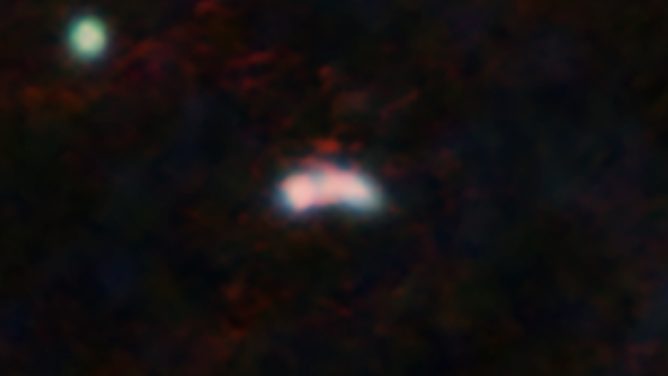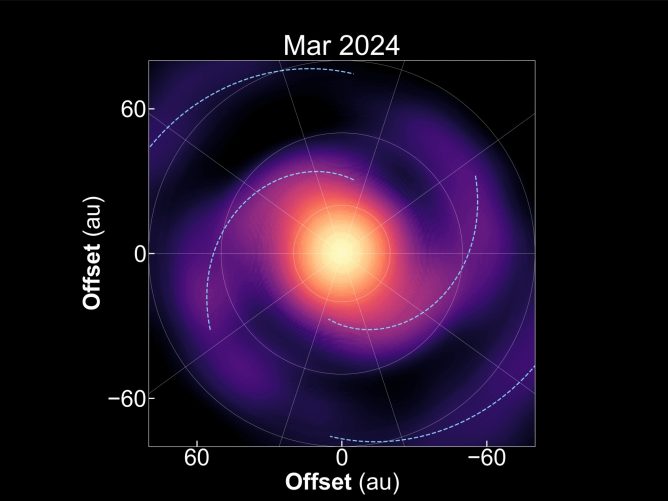2023.06.28
ALMA Digs Deeper into the Mystery of Planet Formation

Artistic image of a disk around a protostar. Credit: ALMA (ESO/NAOJ/NRAO)
The origins of our solar system and extrasolar planetary systems is one of the most important themes in modern astronomy. Our Sun formed about 4.6 billion years ago and all Sun-like stars from through a similar process. As part of this process, a disk forms around the newborn star and within these disks planets will form. These ‘proto-planetary’ disks are expected to only last a few million years, meaning that a forming planetary system only has this amount of time to finish its formation. However, it is still not clear just how rapidly planet formation begins within their disks. Recent ALMA observations have revealed that many proto-planetary disks have substructures such as gaps and rings. This is strong evidence that planets are forming and sweeping up material from the disk. On the other hand, many proto-planetary disks show such signs, suggesting that planet formation is already in progress or has almost completed in the systems we typically refer to as ‘proto-planetary disks’. “These previous results motivated us to examine even younger disks around protostars to answer the question, at what stage of star formation do planet forms,” says Ohashi.
With this motivation, the team focused on disks around protostars, systems that are only 10,000 to 100,000 years old, and observed the radio emission emitted from dust grains, i.e., the building blocks of planets, in disks with ALMA. Previous studies have only observed a small handful of protostars with the resolution necessary to detect signs of planet formation. The international team observed disks around 19 protostars located within about 650 light-years from the Earth utilizing the very high angular resolution of ALMA to examine the structure of the protostellar disks in detail. This is the first systematic study to investigate the detailed structure of disks around a large sample of protostars with such a high angular resolution.
The observations confirmed that there are disks around all the protostars, meaning that the minimum conditions for planet formation are already present in these young protostar systems. However, the observations clearly show that the disks around protostars are different from more-evolved proto-planetary disks. Among the 19 protostars, rings, and gaps, which are signs of planet formation, were observed only in a few disks toward the most evolved protostars. Moreover, the ring structures are less distinct than those seen in the proto-planetary disks. It was also found that the dust (building blocks of planets) in many disks, is not settled in the disk midplane. Rather the dust is aloft, above the disk midplane, making the disks appear thick in the vertical direction. In more-evolved disks, in contrast, the dust settles down in the midplane thereby making them appear much thinner. “We did not expect to see such clear differences between disks around protostars and more-evolved disks,” says Ohashi. John Tobin, a Co-PI of the program at the National Radio Astronomical Observatory (USA) adds “Our results suggest that disks around protostars are not fully ready for planet formation. We believe that the actual formation of the planetary system progresses rapidly in the 100,000 years to 1,000,000 years after star formation begins”.
Jes Jørgensen, the other Co-PI of the program at the Niels Bohr Institute of University of Copenhagen (Denmark) also mentions the importance of international cooperation in planning and implementing such a large-scale program. “There are 37 researchers from 15 research institutes participating in the international research group that promoted this research. In addition, about half of them are graduate students or young researchers who have recently obtained their Ph.D. This research gives many young researchers the opportunity to participate in large-scale international programs, and it can be said that this program plays a major role in nurturing future research and collaboration.”

Images of disks around 19 protostars, including 4 binary systems observed with the ALMA. For 1 binary system, disks around the primary and secondary are presented independently (2nd line rightmost and 3rd line leftmost). Disks are presented in the order of their evolutionary sequence (the one in the upper-left corner is the youngest while the one at the lower-right corner is the oldest). The two oldest disks show faint ring-gap structures. A scale bar of 20 au (1 au corresponds to the distance between the Earth and the Sun, which is 150 million kilometer) is shown for each disk image. Credit: ALMA (ESO/NAOJ/NRAO), N. Ohashi et al.
About ALMA
The Atacama Large Millimeter/submillimeter Array (ALMA), an international astronomyfacility, is a partnership of the European Organisation for Astronomical Research in theSouthern Hemisphere (ESO), the U.S. National Science Foundation (NSF) and the National Institutes of Natural Sciences (NINS) of Japan in cooperation with the Republic of Chile. ALMA is funded by ESO on behalf of its Member States, by NSF in cooperation with the National Research Council of Canada (NRC) and the National Science and Technology Council (NSTC) in Taiwan and by NINS in cooperation with the Academia Sinica (AS) in Taiwan and the Korea Astronomy and Space Science Institute (KASI).
ALMA construction and operations are led by ESO on behalf of its Member States; by theNational Radio Astronomy Observatory (NRAO), managed by Associated Universities, Inc. (AUI), on behalf of North America; and by the National Astronomical Observatory of Japan (NAOJ) on behalf of East Asia. The Joint ALMA Observatory (JAO) provides the unified leadership and management of the construction, commissioning and operation of ALMA.
Acknowledgements
This work was supported by JSPS KAKENHI Grant Numbers JP16H05998, JP18H05440, JP21H04487, JP21H00048, JP18H05222, JP20H05844, JP20H05847, JP21H04495, and by NAOJ ALMA Scientific Research grant No.2019-13B and No.2022-20A, and other funding agencies worldwide.
Publication information:
Initial results of the research are detailed in a series of 18 articles. Five of them, including Ohashi et al. presenting the overview of the program, were accepted in the Astrophysical Journal, and the first 4 are published on June 28, 2023 in the Astrophysical Journal. Preprints of the 5 articles are also appeared in arXiv on June 28, 2023. In addition, more articles based on further detailed analysis are in preparation.
Nagayoshi Ohashi et al. “Early Planet Formation in Embedded Disks (eDisk). I. Overview of the Program and First Results”
Zhe-Yu Daniel Lin et al. “Early Planet Formation in Embedded Disks (eDisk). II. Limited Dust Settling and Prominent Snow Surfaces in the Edge-on Class I Disk IRAS 04302+2247”
Merel L.R. van ‘t Hoff et al. “Early Planet Formation in Embedded Disks (eDisk). III. A First High-resolution View of Submillimeter Continuum and Molecular Line Emission toward the Class 0 Protostar L1527 IRS”
Yoshihide Yamato et al. “Early Planet Formation in Embedded Disks (eDisk). IV. The Ringed and Warped Structure of the Disk around the Class I Protostar L1489 IRS”
Miyu Kido et al. “Early Planet Formation in Embedded Disks (eDisk). VII. Keplerian Disk, Disk Substructure, and Accretion Streamers in the Class 0 Protostar IRAS 16544–1604 in CB 68”









